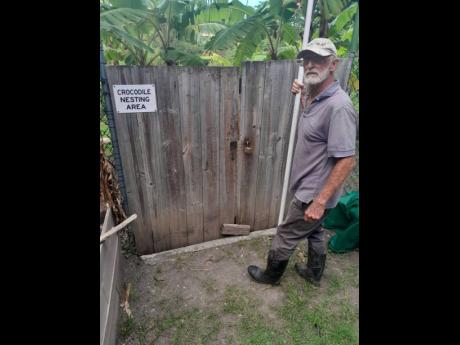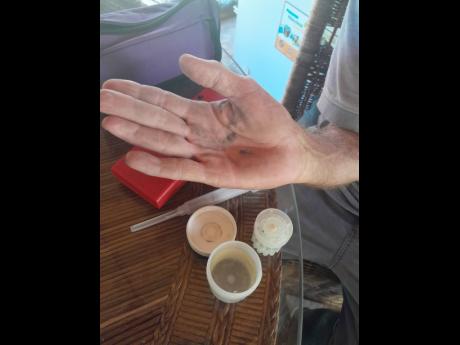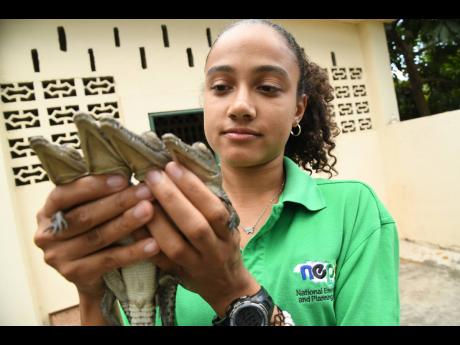A ferocious problem
Crocodile experts call on authorities to do more to protect endangered species
They enjoy protected status and pride of place atop Jamaica’s coat of arms – a symbol of unending resilience and the strength of the Jamaican people. Yet over decades, their habitats have been decimated to make room for development, and their bodies mutilated for its meat – a delicacy in some underground circles.
It is a story told times over, but one that continues to fall on the deaf ears of Jamaicans too busy going about their daily lives to listen. Very few have time to understand the “gravity of the situation”, and it leaves crocodile expert Lawrence Henriques heartbroken.
“Jamaicans don’t have time to care about crocodiles. Everybody has their own lives going, trying to make money to pay their bills,” bemoaned Henriques, who heads the Holland Crocodile Sanctuary, located in deep rural St Thomas.
The crocodile enthusiast is deeply perturbed by the threat of extinction of the reptiles.
“The vast majority of our crocodile population is being exterminated, basically due to poaching, indiscriminate killing, as well as habitat loss,” Henriques explained to The Sunday Gleaner. “By losing a lot of their habitat, good quality nesting areas, nesting now is not as prevalent or successful as it used to be.”
“Poaching is another serious problem. If the poachers are catching and killing larger crocodiles (for meat), potential breeding animals, then we are going to have a hell of a problem with the population continuing,” he cautioned.
Jamaica is home to one species of crocodile, the American crocodile ( Crocodylus acutus), found mainly along the south coast and in sections of Hanover and Trelawny.
Since 1971, crocodiles have been classified as an endangered and protected species in Jamaica. Under Section 6 of the Wildlife Protection Act, it is considered an offence to hunt them or to have in one’s possession any part of the animals or their eggs. Under Section 20 of the act, harming or hunting the reptiles can result in fines of up to $100,000 or 12 months in prison.
A GRIM FUTURE
There are more than 61 crocodiles at Henriques’ sanctuary, 25 of which are more than seven feet long. Despite their appearance and hostile temperament, Henriques regards the crocodiles as his children. He refers to them by name: Blacks, Harry, Elizabeth, Kim, Julie – and they obey his commands.
Pirate, a nine-foot crocodile, suns at a makeshift creek outside his owner’s front door. Then there are larger ones – Rogue, Thrasher and Triple X – which range between 12 and 13 feet, and weigh between 700 and 800 pounds.
In the last two years, 79 baby crocodiles have been microchipped and released into the wild from the Holland Sanctuary. The initiative is called the Headstart Programme, a collaboration between the sanctuary and the National Environment and Planning Agency (NEPA). Release happens about twice a year.
But even with a head start, these animals face a grim future, noted Henriques, who said poaching may be impacting the tracking of the animals.
Each of the pencil-point-sized microchips costs about US$10 and are injected into the reptiles’ tails. Their status can then be read up close using a handheld device. Poachers, however, are in the habit of chopping off the crocodiles’ tails and limbs, taking with them the implanted microchips and leaving behind the rest of the carcass.
On countless occasions, Henriques has stumbled upon mutilated crocodiles, killed not far from the St Thomas sanctuary. In some instances, he has found snares and other contraptions with bait tied in trees by hoodlums hoping to catch the animals.
Henriques said implanting the chip in the tail is merely a best practice; there are other areas, albeit more technical, where they can be placed. Thus, he is in dialogue with NEPA for microchip placement changes.
Annually, the crocodiles at the sanctuary consume about 14,000-15,000 pounds of meat, most of which is rejected poultry contributed by chicken companies. Outside of that, it costs some US$25,000 to keep the facility running each year. Henriques said he gets assistance mainly from overseas partners.
“Where is the resources? NEPA can only do so much, and this is the problem we face,” he said, pointing to a lack of wildlife law enforcement.
“When you have a situation in Jamaica, where, unfortunately, a large per cent of our population is very indisciplined, and they have scant regard for the law, it is very difficult to try and exert some sort of control over situations.”
Henriques is calling for accountability from the relevant authorities for wildlife, particularly crocodiles, and the destruction of their wetlands to make homes. Communities such as Greater Portmore in St Catherine, which were once vast crocodile habitats, are prime examples, he charged.
‘ECOSYSTEM ENGINEERS’
Treya Picking, a crocodile biologist and master’s student at The University of the West Indies (UWI), said a boost in construction and developments across the island in recent decades have resulted in the increased likelihood of encounters between humans and crocodiles. Flooded waterways, sewage treatment plants, and gullies prompt the movement of the animals in search of food or to lay eggs, she said.
Picking described the crocodiles as “ecosystem engineers” with a duty of keeping Jamaica’s mangroves safe.
According to scientific reports, more than 770 hectares of mangroves across Jamaica have been destroyed over the last 20 years. St Elizabeth, Clarendon, St Catherine, and Trelawny are reportedly the hardest hit, while mangrove losses are the lowest in St Thomas and Westmoreland.
Picking explained that coastal development has been the main reason for mangrove loss. Tourism and residential expansion are the major problems in the north of the island, while in the south the problems are tied to port and industrial development.
Other mangroves, particularly in Kingston, the expert explained, have been lost through pollution and unhealthy practices such as coal burning.
“The increasing development along the south coast for both residential and commercial activities has forced crocodiles to seek out new areas such as storm drains, and fish and sewage ponds, to inhabit,” the biologist said.
“While crocodiles are highly adaptive, movement into new areas can result in more human-crocodile interactions. A prime example is the community of Portmore, one of the largest urban areas in St Catherine. It was built on reclaimed swamp land in the 1960s.”
Picking continued, “Since then, crocodiles became displaced and over time adapted by using the intricate canal system to migrate between habitats. As a result, the community of Portmore has one of the highest human-crocodile interactions in Jamaica.”
She also pointed out that, “Illegal hunting since the early 2000 is also a serious problem impacting the crocodiles’ survival. The demand for crocodile meat, particularly the tail, has been fuelled by the myth of it being an aphrodisiac and seen as a delicacy among certain demographics. Over time, this illegal activity has increased based on the number of reported cases and the growing value of crocodile meat on the black market.”




